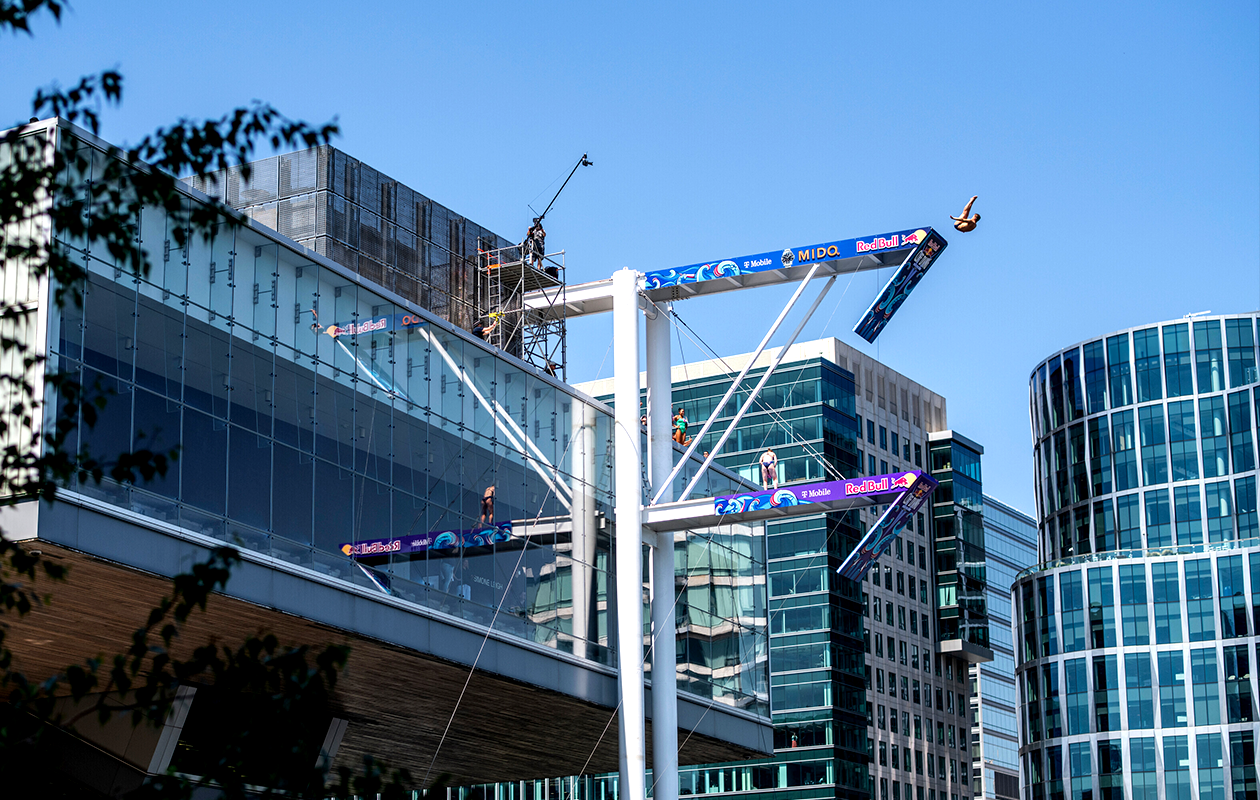T-Mobile on Monday touted a term that the wireless industry loves to talk about, but may go over the head of everyone else: Network slicing.
While you may dismiss network slicing as another in an endless wave of technical jargon in the wireless world, it’s actually a big deal with ramifications on how you may live your life down the line.
Network slicing is the act of essentially carving out a dedicated slice of spectrum, or the radio airwaves that ferry data wirelessly from your phone to a nearby cell tower, for a specific service. If cellular service is a 6-lane highway, then network slicing is creating a new, single, separate lane especially for one car.
T-Mobile Chief Technology Officer John Saw publish a blog post about an effort to create a dedicated network for the remote video production of Red Bull’s Cliff Diving event in Boston. While wireless companies have offered these kinds of private networks for years at business facilities, T-Mobile said this is the first time it was pulled off at a remote location.
“This customized slice gave the broadcast team supercharged wireless uplink speeds so they could easily and quickly transfer high-resolution content from cameras and a video drone circling the event to the Red Bull production team in near real-time over T-Mobile 5G,” Saw said. “Meanwhile, nearly 20,000 visitors were in attendance, using their devices as they normally would – uploading pictures and videos of the event. Because of network slicing and traffic management, their traffic did not impact the Red Bull production – and vice versa.”
A private network sounds nice, but there’s a lot to get your head wrapped around. Here’s a breakdown of everything you need to know about network slicing.
When did network slicing appear?
The idea of partitioning off a bit of the network for a dedicated purpose came with the introduction of 5G. The ability to flexibility manage the network and slice off parts was a key innovation in the fifth-generation of wireless technology.
How come I’ve never heard of it?
Unless you’re in the wireless industry or work logistics for a company, chances are this is a foreign term for you. That’s because the big wireless carriers have largely offered this to business customers. The idea is these warehouses, factories or other office spaces would get dedicated spectrum to ensure a certain quality of coverage. The wireless connection could even be tuned to run faster or slower based on the need, with factories running automated equipment likely needing higher bandwidth connectivity vs. a standard office.
Is T-Mobile the only one offering this?
No, T-Mobile is just one of a myriad of companies offering private networks. AT&T and Verizon are the other big players, but there are a number of smaller companies utilizing so-called shared spectrum to build these private networks, according to Digital Global Systems, which offer the tools to assess how these types of connections work in different places.
“The manufacturing plant of today has changed completely,” said Alan Pritchard, a business development executive for Digital Global Systems, in an interview last week. “None of the plants are wired with fiber. They want the whole thing to be wireless.”
If this has been around for a while, why is the T-Mobile Red Bull setup such a big deal?
While there have been a lot of networks set up to be run on a permanent facility, this is the first time a temporary dedicated network was set up remotely with the intention of being torn down later.
Why couldn’t Red Bull just use the standard T-Mobile network?
Video production and the transferring of high-resolution feeds takes tremendous uplink and downlink speeds. If it ran on the public T-Mobile network, it would monopolize the capacity and kill the connection for every T-Mobile subscriber in the area. Saw noted that the Red Bull network was running at uplink speeds of 276 Mbps.
A private network sounds great. Where do I get one?
Sorry, this isn’t a service that consumers can sign up for. This is typically a business-grade offering.
Okay, but how does this affect me?
Network slicing is dedicated to businesses right now, but the carriers are looking at specific applications. One of the big killer apps that has long been touted is autonomous driving. A wireless company could set up specific radios with dedicated spectrum running into a network of self-driving cars, allowing them to talk with each in real time to better avoid accidents.
“Did you see what happened to a bunch of robo-taxis in San Francisco earlier this month? They caused a traffic jam when the wireless network supporting them had issues – largely because of the increased data usage at a nearby concert,” Saw said. “With network slicing, we can work with communities to make key infrastructure and transportation networks more reliable, helping to prevent something like that from happening again.”
Any other applications?
You can see other applications for dedicated spectrum usage such as virtual reality or augmented reality experiences, which take huge amounts of bandwidth. AR systems like Microsoft’s HoloLens or Apple Vision Pro headsets could benefit greatly from these kinds of connections. T-Mobile earlier this month launched a network slicing beta to help developers create better video calling applications.
Anything else?
This is really just the start of networking slicing. The future will see more kinds of companies using a broad array of spectrum, and not just the dedicated airwaves that companies like T-Mobile and Verizon pay a fortune for the exclusive rights to. There are frequencies like the Citizens Broadband Radio Service band that has multiple parties using it, including one crypto-powered 5G plan. That means networking slicing and the ability to partition off bits of the airwaves for specific use will be more critical over time.
“Sharing is the mechanism as time goes by,” Global Digital Systems CEO Armando Montalvo said in an interview last week.

